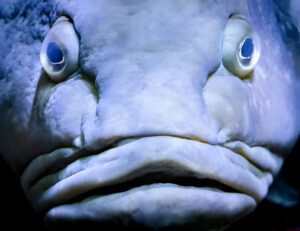Have you ever wondered why some fish have such big eyes? How do they survive in the dark and hostile depths of the ocean? What makes them different from other fish that have small or normal-sized eyes? In this blog post, we will explore the fascinating world of fish with big eyes, and learn about their types, advantages, disadvantages, and adaptations.
What are fish with big eyes?
Fish with big eyes are a group of fish that have unusually large eyes compared to their body size. They are mostly found in the deep sea, where light is scarce and visibility is low. Their big eyes help them to see better in the dark, and to detect prey, predators, and mates. Some of them also have bioluminescent organs that produce light to attract or confuse other animals.
Fish with Big Eyes
Barrel eyes: These fish have transparent, dome-shaped heads that enclose their eyes. Their eyes can rotate within their heads to look upwards or forwards. They feed on small animals that drift down from the surface.
Spookfish: These fish have tubular eyes that point upwards to scan the water above them. They also have mirror-like structures in their eyes that reflect light downwards to see the objects below them. They are the only vertebrates that use mirrors for vision.
Lanternfish: These fish have large, round eyes that glow in the dark. They also have rows of bioluminescent spots along their bodies that create patterns of light. They use their light to communicate, camouflage, and lure prey.
Dragonfish: These fish have long, slender bodies and fearsome teeth. They have large eyes that can see in the infrared spectrum, which means they can see the heat emitted by other animals. They also have a bioluminescent barbel that hangs from their chin, which they use to attract prey.
What are the advantages and disadvantages of having big eyes?
Having big eyes has both advantages and disadvantages for these fish. Some of the advantages are:
Enhanced vision: Big eyes allow these fish to capture more light and see better in the dark. They can also see a wider range of colors and wavelengths, such as ultraviolet and infrared, that are invisible to other fish.
Bioluminescence: Some fish with big eyes can produce light or reflect light with their eyes or other organs. This gives them an edge over other animals that rely on natural light sources, such as the sun or the moon. They can use their light to find food, avoid danger, or attract mates.
Camouflage: Some fish with big eyes can blend in with their surroundings by adjusting the brightness or color of their eyes or bioluminescent spots. This helps them to hide from predators or ambush prey.
Some of the disadvantages are:
Predation: Big eyes make these fish more visible and vulnerable to predators that can see them. They also have to deal with the risk of being blinded by the bright flashes of light from other bioluminescent animals or human-made sources, such as submarines or fishing boats.
Energy cost: Big eyes require more energy and resources to maintain and operate. They also take up more space and weight in the fish’s body, which can affect their mobility and agility.
How do fish with big eyes compare with other fish?
Fish with big eyes are different from other fish that have small or normal-sized eyes in many ways. Some of the differences are:
Depth: Fish with big eyes live in the deep sea, where light is scarce and pressure is high. Other fish live in the surface or mid-water layers, where light is abundant and pressure is low.
Size: Fish with big eyes are usually small or medium-sized, ranging from a few centimeters to a few meters in length. Other fish can vary in size, from tiny plankton to giant whales.
Diet: Fish with big eyes are mostly carnivorous, feeding on small animals that drift down from the surface or live in the deep sea. Other fish can be herbivorous, omnivorous, or carnivorous, depending on their habitat and availability of food.
Diversity: Fish with big eyes are relatively less diverse, belonging to a few families and genera. Other fish are more diverse, belonging to hundreds of families and thousands of genera.
What are some interesting behaviors or adaptations of fish with big eyes?
Fish with big eyes have some interesting behaviors or adaptations that help them survive and thrive in the deep sea. Some of them are:
Vertical migration: Some fish with big eyes, such as lanternfish, migrate vertically every day, following the movement of their food and light sources. They rise to the surface at night to feed on plankton and other animals, and descend to the depths during the day to avoid predators and conserve energy.
Symbiosis: Some fish with big eyes, such as dragonfish, have symbiotic relationships with bacteria that live in their bioluminescent organs. The bacteria provide the fish with light, and the fish provide the bacteria with nutrients and protection.
Communication: Some fish with big eyes, such as spookfish, use their eyes or bioluminescent spots to communicate with each other. They can signal their identity, location, mood, or intention to their mates, rivals, or predators.
See also: Animals that live in the desert
Conclusion
Fish with big eyes are amazing creatures that have adapted to the harsh and mysterious environment of the deep sea.
They have big eyes that help them to see better in the dark, and to produce or reflect light for various purposes.
They are different from other fish that have small or normal-sized eyes in many aspects, such as depth, size, diet, and diversity. They also have some interesting behaviors or adaptations, such as vertical migration, symbiosis, and communication.


